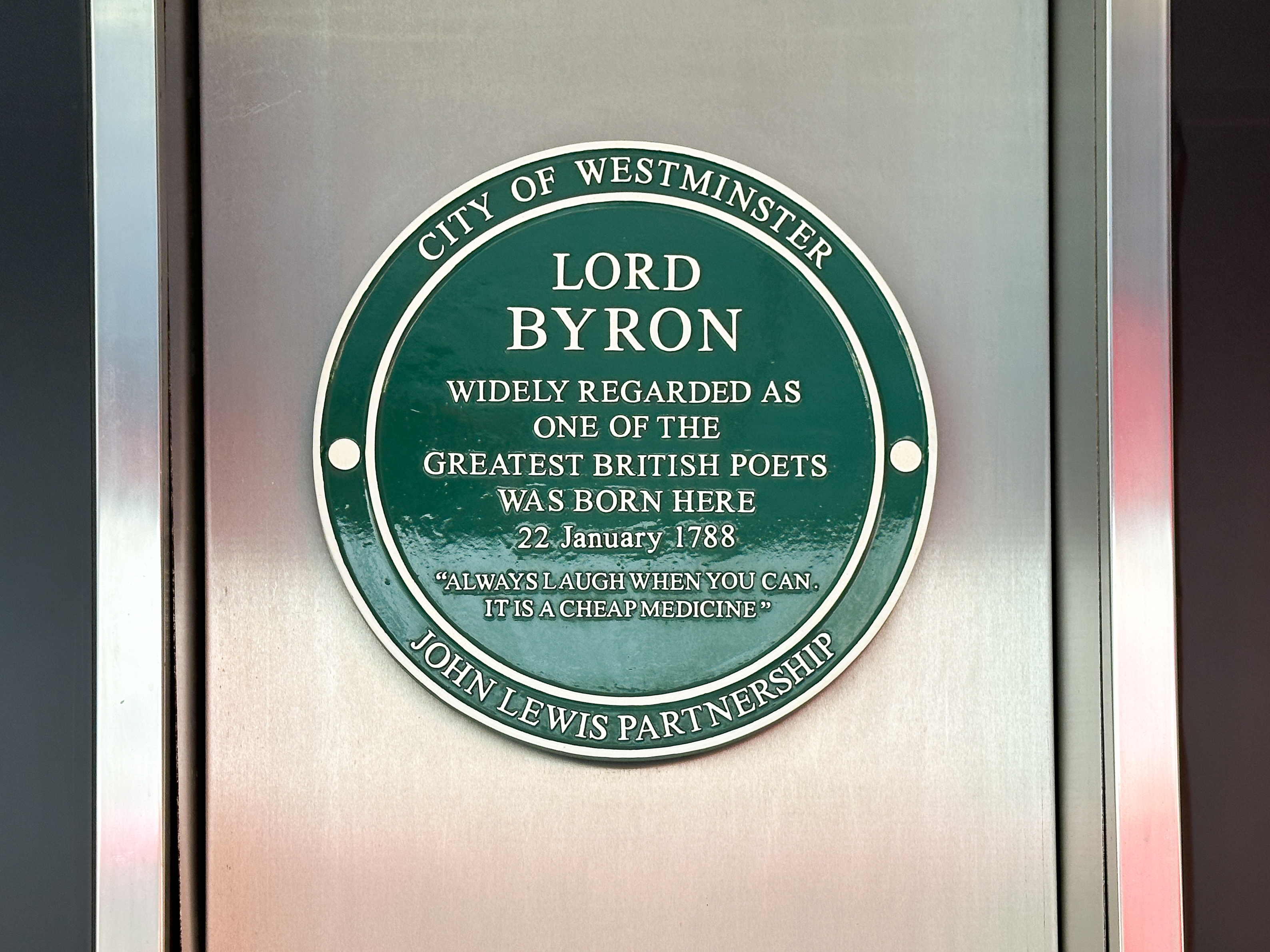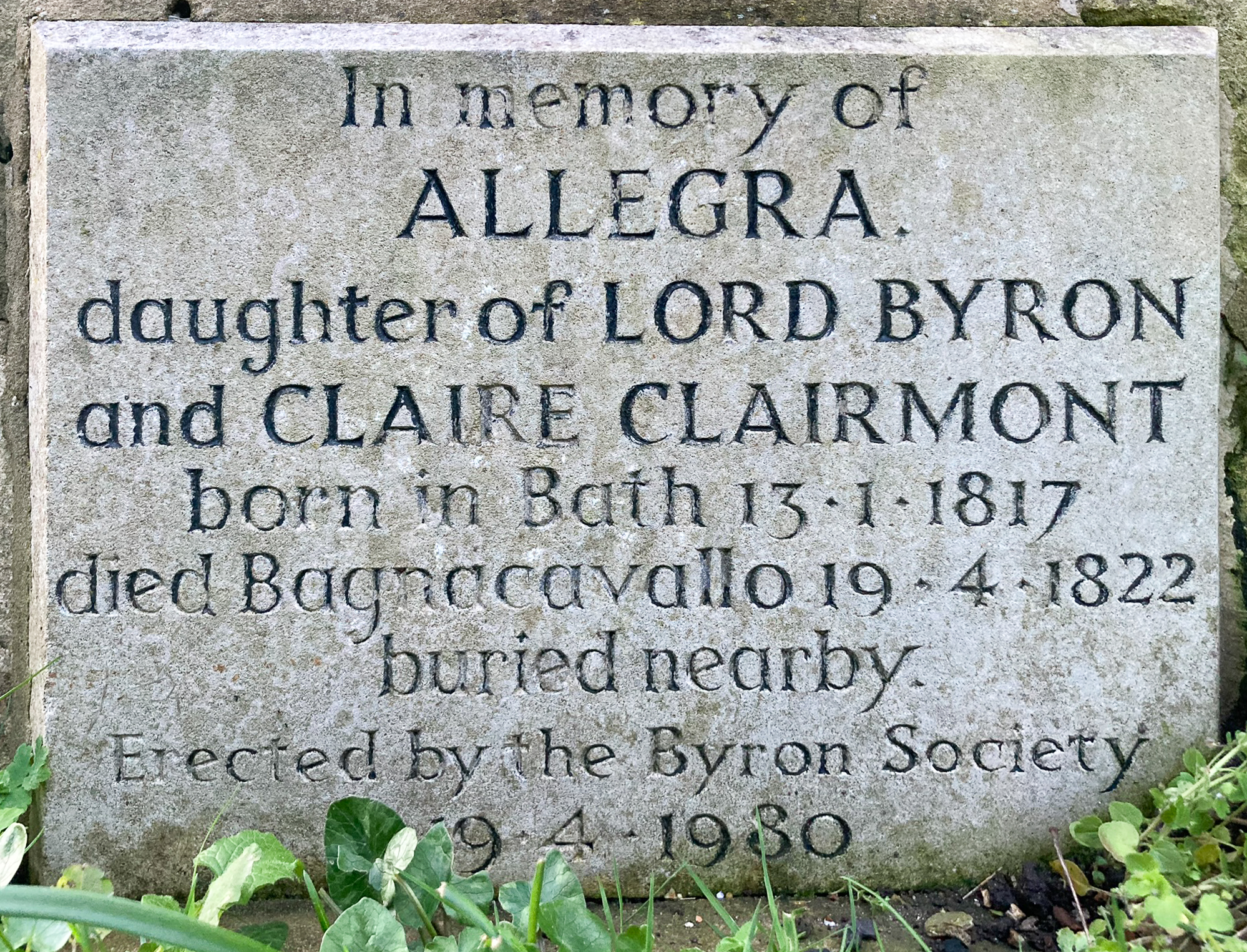The first ever blue plaque to be put up in London was on the front of the house in which Lord Byron was born. Or at least, it was on the house in which those who were running the scheme believed he’d been born (see Commemorating Lord Byron on Holles Street). There remains some confusion, even to this day, about the precise address at which the Byrons were living at the time.
The blue plaque scheme was set up in the mid-1860s, and Byron, although dead for over forty years by then, was still a huge literary celebrity. He was thus precisely the sort of person the initiative was designed to commemorate – someone ‘whose work or actions have had a notable impact on British life and have helped shape British “heritage”’.
Unfortunately, the house in Holles Street in which he was born, along with the plaque which adorned it, became a victim of late-nineteenth century regeneration. The site is now occupied by John Lewis’s Oxford Street branch, and although a new plaque was later affixed to the concrete wall of the department store, this doesn’t provide quite the same historical resonance.
The aim behind the blue plaque scheme was not merely to commemorate notable individuals from the past – this had been going on for millennia, after all, through the building of monuments and statues. Instead, it was to link person and place, and establish a monument on the actual building where the notable person had lived or worked. The city itself, in other words, was to become the monument, with the plaque simply drawing the passers-by’s attention to this detail from history. And just as you and I are shaped a little by the physical environment in which we live, so perhaps, the contention was, we can get a better understanding of the historical figure by standing in their literal footsteps.
 A commemorative plaque honouring Lord Byron, one of the greatest British poets, born on 22 January 1788.The image shows a circular green plaque with white text, mounted on a wall. It is dedicated to Lord Byron, one of the greatest British poets. The plaque indicates that Byron was born at this location on 22 January 1788. A quote at the bottom reads, “Always laugh when you can. It is cheap medicine.” The plaque is sponsored by the John Lewis Partnership and is located in the City of Westminster.
A commemorative plaque honouring Lord Byron, one of the greatest British poets, born on 22 January 1788.The image shows a circular green plaque with white text, mounted on a wall. It is dedicated to Lord Byron, one of the greatest British poets. The plaque indicates that Byron was born at this location on 22 January 1788. A quote at the bottom reads, “Always laugh when you can. It is cheap medicine.” The plaque is sponsored by the John Lewis Partnership and is located in the City of Westminster.
One problem with this idea, however, is that the urban landscape is in a continual state of flux – and the John Lewis-Byron plaque is a prime example of this. Standing in the shadow of the modern department store is unlikely, after all, to offer the passer-by much insight into the circumstances of Byron’s birth. But while this particular example shows the limitations of the idea, there are other instances where the landscape of London might afford insights into Byron’s biography, and particularly to some of his relationships.
In the last months in which Byron lived in London, he embarked on an affair with Claire Clairmont. There are no blue plaques, or indeed any other forms of memorial, to Claire Clairmont in London, as she tends to be portrayed simply as a supporting actor in the story of the Romantics: lover of Byron, stepsister to Mary Shelley, stepdaughter to William Godwin, and the creator of nothing much – except a collection of what are now acknowledged to be extremely fine letters.
Although somewhat eclipsed by her overachieving family and friends, she is nevertheless a fascinating individual in her own right. Were there to be a commemorative plaque put up one day to her, where might it be placed? In her early life in London, Claire lived mostly with one or other of those more famous figures in her life – the Shelleys or William Godwin. She grew up in Somers Town, where there’s a memorial to her step-father’s first wife, Mary Wollstonecraft. She then shared the peripatetic existence of Percy and Mary Shelley as they eluded Shelley’s creditors in the winter of 1815 – there are plaques on Nelson Square and Marchmont Street memorialising residences occupied by the trio but only naming Mary and Percy. Even in Bath where she gave birth in secret to Allegra, her daughter by Byron, there’s a plaque commemorating Mary’s writing of Frankenstein in the town.
Plaques are frequently placed in locations where the notable person spent but the briefest of times. The Shelleys stayed only two months at the Nelson Square address and just a few weeks at Marchmont Street. If these fleeting residences can be memorialised, perhaps we could go one further and memorialise the street corner from which Claire sent a messenger to Lord Byron with a letter which was to have great consequence for both their lives. In this letter she proposed that they consummate their affair by going ‘out of town together by some stage or mail about the distance of 10 or 12 miles. [T]here we shall be free & unknown; we can return early the following morning.’ She waited for his reply in Hamilton Place, a short connecting street between Park Lane and Piccadilly. Byron sent his reply along with a copy of the Morning Post for her to read, for all the world as if she were in a dentist’s waiting room. It contained an article criticising him for writing two poems on his recent separation from his wife, which he thought ‘will amuse you’. The consequences of this brief exchange were to influence the course of the rest of Claire’s life.
 A memorial plaque for Allegra, daughter of Lord Byron and Claire Clairmont. Birth: 13.1.1817. Death: 19.4.1822. Erected by the Byron Society in 1980.The weathered stone plaque stands amidst lush greenery, its surface etched with the weight of history. It serves as a poignant memorial, commemorating Allegra, the daughter of two literary figures: Lord Byron and Claire Clairmont.
The engraved text on the plaque reads as follows:
In memory of ALLEGRA
daughter of LORD BYRON
and CLAIRE CLAIRMONT
born in Bath 13/01/1817
died Bagnacavallo 19/04/1822
buried nearby.
Erected by the Byron Society 1980
A memorial plaque for Allegra, daughter of Lord Byron and Claire Clairmont. Birth: 13.1.1817. Death: 19.4.1822. Erected by the Byron Society in 1980.The weathered stone plaque stands amidst lush greenery, its surface etched with the weight of history. It serves as a poignant memorial, commemorating Allegra, the daughter of two literary figures: Lord Byron and Claire Clairmont.
The engraved text on the plaque reads as follows:
In memory of ALLEGRA
daughter of LORD BYRON
and CLAIRE CLAIRMONT
born in Bath 13/01/1817
died Bagnacavallo 19/04/1822
buried nearby.
Erected by the Byron Society 1980
While there may be no memorial plaques to Claire Clairmont in London, there is one to the product of her relationship with Bryon: their daughter, Allegra. And here again the history of the plaque echoes elements of the combined biographies of the child and her parents.
Soon after Allegra’s first birthday, Byron took over responsibility for her care, thus separating her forever from Claire. He sent her to be educated at a convent near Ravenna, Italy, where, at age five, she died of a fever. Byron arranged for the body to be sent back to England, with a degree of pomp in its final leg that was to foreshadow Byron’s own funeral procession (Byron himself died in Greece exactly two years to the day after Allegra). Allegra’s little coffin was transported from the dock in London to Harrow with ‘a hearse and a mourning coach, each with four horses with feathered plumes and velvet coverings, two porters, four hearse bearers, two coach pages with wands,’ and sundry other accoutrements. She was buried in St Mary’s Church in Harrow on the Hill, close to where Byron had gone to school. Due to his unsavoury reputation, however, the vicar insisted that she be buried in an unmarked grave at the very edge of the church itself. It wasn’t until 1980 that the Byron Society managed to secure permission to have a plaque put up to commemorate her death.
This plaque both memorialises Allegra and acknowledges Claire as her mother, but it is placed in a location that had nothing to do with either of them, and was meaningful only to Byron himself. It is sadly fitting that – at least through physical memorials – the lives of these two women are wholly subsumed into Byron’s biographical narrative.



Rate and Review
Rate this article
Review this article
Log into OpenLearn to leave reviews and join in the conversation.
Article reviews